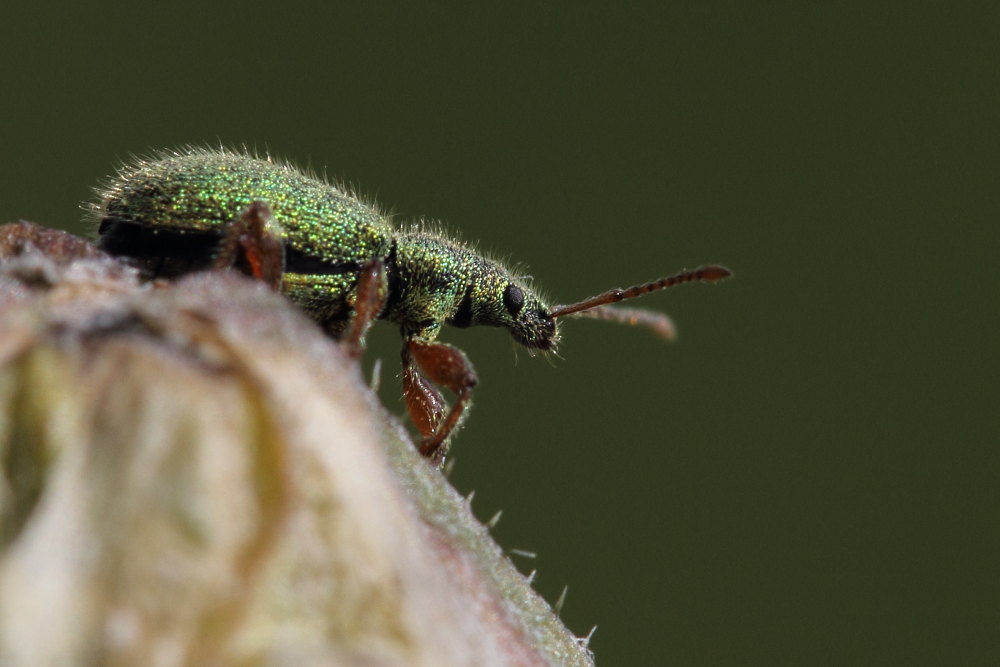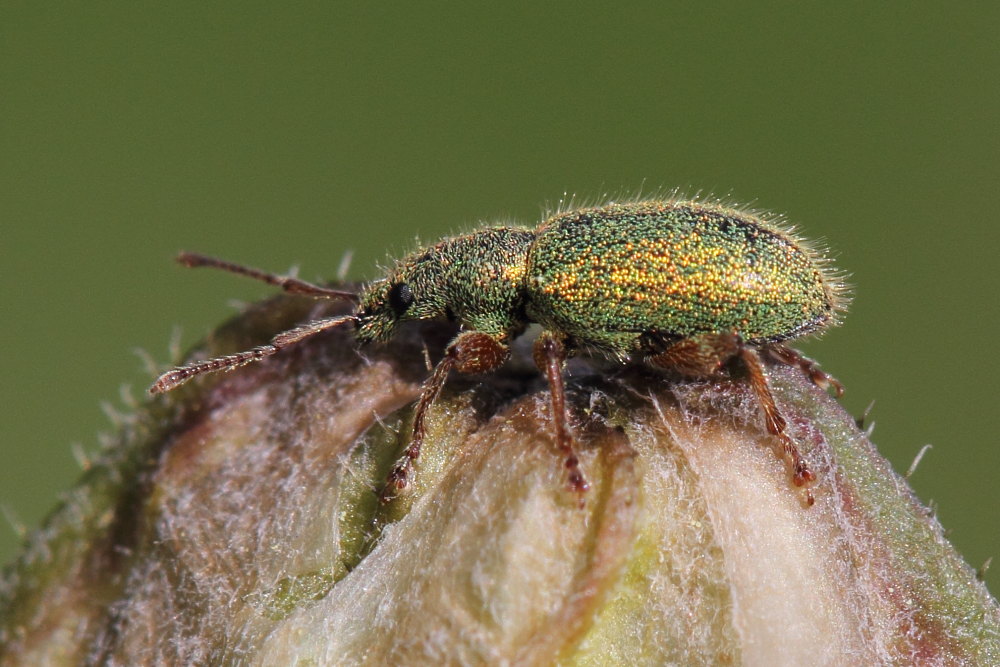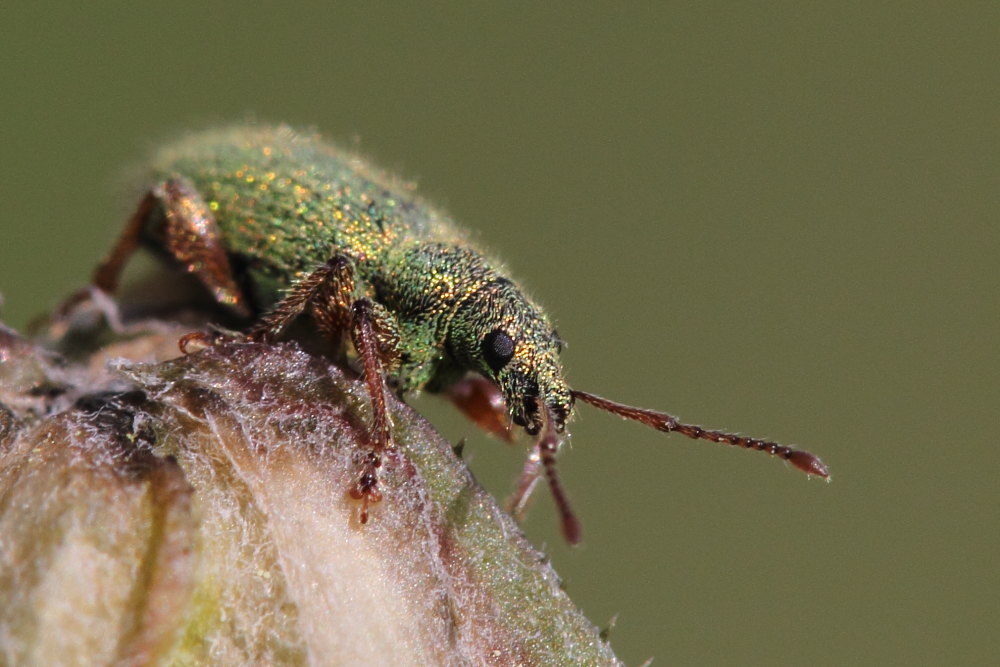| Autore |
 Discussione Discussione  |
|
|
mbondini
Utente Super
    
CittÓ: Agugliano
Prov.: Ancona
Regione: Marche

5810 Messaggi
Tutti i Forum |
|
|
mbondini
Utente Super
    
CittÓ: Agugliano
Prov.: Ancona
Regione: Marche

5810 Messaggi
Tutti i Forum |
 Inserito il - 29 aprile 2013 : 17:52:43 Inserito il - 29 aprile 2013 : 17:52:43


|
Il secondo esemplare: lungo al massimo 5 millimetri.
Immagine:

95,66 KB
Immagine:

168,9 KB
Immagine:

136,15 KB |
 Marco Marco
Link |
 |
|
|
Forbix
Moderatore
    

CittÓ: Portoferraio
Prov.: Livorno
Regione: Toscana

6989 Messaggi
Flora e Fauna |
 Inserito il - 29 aprile 2013 : 18:55:46 Inserito il - 29 aprile 2013 : 18:55:46


|
Quello pi¨ grande Ŕ quasi senza dubbio un:
Polydrusus formosus (Mayer, 1779) = sericeus Schaller, 1783
...per quanto riguarda il pi¨ piccino, non riesco a capire bene neanche se Ŕ un Polydrusino o un Phyllobino.....insomma non lo conosco!!
......per ora!  |
Forbix
|
 |
|
|
Klaas Rei▀mann
Utente Senior
   
CittÓ: Kamp-Lintfort, Nordreno-Vestfalia
Regione: Germany

1614 Messaggi
Tutti i Forum |
 Inserito il - 30 aprile 2013 : 00:20:22 Inserito il - 30 aprile 2013 : 00:20:22


|
I don't think it is Polydrusus fromosus. #1 and #2 seem to be, but the distance between the eyes does not fit. P. formosus has got bigger eyes. The interstriae can normaly be seen more clearly. The end of the antennae is not dark enough. In P. formosa it is black. I don't think it is P. formosa. Because of a number of similar species I can't tell anything for sure, but I guess that's Polydrusus prasinus.
#3, #4 and #5 is something totaly different. In my mind genus Phyllobius. I can't see the frontal femur well. If there is a big thorn on the downside of the Femora it might be Phyllobius betulinus. But that's only a guess.
Ciao
Klaas |
|
 |
|
|
Forbix
Moderatore
    

CittÓ: Portoferraio
Prov.: Livorno
Regione: Toscana

6989 Messaggi
Flora e Fauna |
 Inserito il - 30 aprile 2013 : 00:55:44 Inserito il - 30 aprile 2013 : 00:55:44


|
Polydrusus (Eurodrusus) prasinus (Olivier, 1790)
subg. Eurodrusus = Tooth on fore-femurae present.
Antennomeres of the funicle long, club brownish-black = Polydrusus formosus
Antennomeres of the funicle more stout, club yellowish = Polydrusus thalassinus (non presente in Italia).
Posso sicuramente sbagliarmi, ma a me continua a sembrarmi un P. formosus!  |
Forbix
|
 |
|
|
Klaas Rei▀mann
Utente Senior
   
CittÓ: Kamp-Lintfort, Nordreno-Vestfalia
Regione: Germany

1614 Messaggi
Tutti i Forum |
 Inserito il - 30 aprile 2013 : 07:12:15 Inserito il - 30 aprile 2013 : 07:12:15


|
Ciao Leonardo,
just to make sure: are we talking about #1 and #2, or are we talking about #3 - #5? Or do we talk about all five?
Ciao
Klaas |
|
 |
|
|
Forbix
Moderatore
    

CittÓ: Portoferraio
Prov.: Livorno
Regione: Toscana

6989 Messaggi
Flora e Fauna |
 Inserito il - 30 aprile 2013 : 08:39:44 Inserito il - 30 aprile 2013 : 08:39:44


|
I'm talking about the specimen in photos 1 and 2. 
The specimen in pictures 3, 4 and 5 do not know him.
I am sure that is a Entimino, but I'm not sure if it is a Phyllobius or a Polydrusus.
Definitely closer to Phyllobini, but I can not figure out what it is! |
Forbix
|
 |
|
|
Klaas Rei▀mann
Utente Senior
   
CittÓ: Kamp-Lintfort, Nordreno-Vestfalia
Regione: Germany

1614 Messaggi
Tutti i Forum |
 Inserito il - 30 aprile 2013 : 09:57:09 Inserito il - 30 aprile 2013 : 09:57:09


|
I asked, because of your statement | | subg. Eurodrusus = Tooth on fore-femurae present. |
Could you show me where you see a tooth???
Ciao
Klaas |
|
 |
|
|
Forbix
Moderatore
    

CittÓ: Portoferraio
Prov.: Livorno
Regione: Toscana

6989 Messaggi
Flora e Fauna |
 Inserito il - 30 aprile 2013 : 10:08:18 Inserito il - 30 aprile 2013 : 10:08:18


|
That's right. The "tooth" is not there.
is for this reason that I can not be of Polydrusus prasinus (subg. Eurodrusus).
In this subgenus, the tooth femoral think is a distinctive morphological character. |
Forbix
|
 |
|
|
mbondini
Utente Super
    
CittÓ: Agugliano
Prov.: Ancona
Regione: Marche

5810 Messaggi
Tutti i Forum |
 Inserito il - 01 maggio 2013 : 12:20:33 Inserito il - 01 maggio 2013 : 12:20:33


|
Thank you very much,  I'm sorry I was not be able to photograph better these insects to show more details. I'm sorry I was not be able to photograph better these insects to show more details. 
I will classify the first as Polydrusus formosus p. (probable) and the second as Phyllobius m. (maybe) 
Ciao  
Marco |
 Marco Marco
Link |
 |
|
|
Klaas Rei▀mann
Utente Senior
   
CittÓ: Kamp-Lintfort, Nordreno-Vestfalia
Regione: Germany

1614 Messaggi
Tutti i Forum |
 Inserito il - 01 maggio 2013 : 18:13:47 Inserito il - 01 maggio 2013 : 18:13:47


|
| | I will classify the first as Polydrusus formosus p. (probable) and the second as Phyllobius m. (maybe) |
if the identification is not sure, the scientist uses the shortform "cf." of the latin "confer", which is the order for everybody who works with this specimen, to identify it again, because the former determinator is not sure about his identification.
So write: Polydrusus cf. formosus and cf. Phyllobius
Beside this I'm not with Leonardo in the Polydrusus. The tooth he wants to see (or not) can't be seen on tese two photos. In both of them it is hidden behind the femorae, whether there is a tooth or not. And the two beetle do not fit for P. formosus. But don't worry about this. Do it the way you mentioned to do. That's quite ok.
Ciao
Klaas |
|
 |
|
| |
 Discussione Discussione  |
|

 Forum
|
Registrati
|
Msg attivi
|
Msg Recenti
|
Msg Pvt
|
Utenti
|
Galleria |
Map |
Forum
|
Registrati
|
Msg attivi
|
Msg Recenti
|
Msg Pvt
|
Utenti
|
Galleria |
Map |